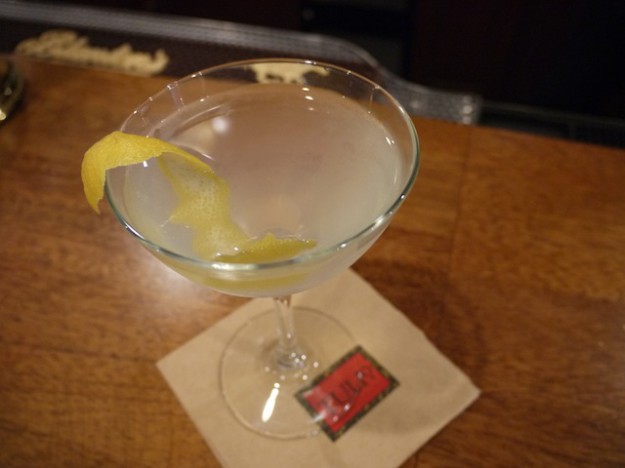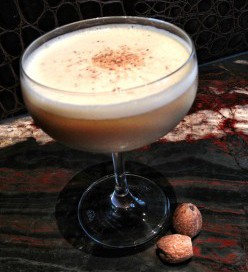A properly made gin martini, mixed with well-maintained dry vermouth, is a thing of beauty. Vermouth, like any wine, will eventually spoil and become vinegary and unpleasant — so it needs to be kept capped, refrigerated, and used within three or four weeks. Oh — and the reason a Dry Martini is called a Dry Martini is because it’s made with dry vermouth. Orators such as Winston Churchill were fond of hyperbolically directing that the closest one should come to vermouth in a martini was to genuflect briefly in the direction of France … pithy, if not exactly delicious.

If you want to experiment with your martini, try varying your proportions of gin and vermouth. I love a 50-50 Martini: equal parts gin and vermouth, stirred, with a dash of orange bitters and a swath of lemon peel for the oil and aroma. If you’d prefer something a little drier, Bernard De Voto, in his cantankerous but eloquent cocktail manifesto The Hour, writes:
There is a point at which the marriage of gin and vermouth is consummated. It varies a little with the constituents, but for a gin of 94.4 proof and a harmonious vermouth it may be generalized at about 3.7 to one. And that is not only the proper proportion but the critical one; if you use less gin it is a marriage in name only and the name is not martini. You get a drinkable and even pleasurable result, but not art’s sunburst of imagined delight becoming real. Happily, the upper limit is not so fixed; you may make it four to one or a little more than that, which is a comfort if you cannot do fractions in your head and an assurance when you must use an unfamiliar gin.
There’s nothing wrong with a Vodka Martini. I enjoy one myself from time to time, particularly when at a steakhouse, prior to consuming more red meat than anyone should in one sitting. For these I typically will specify a vodka; I’m partial to rye-based vodkas for the peppery spice. It is, however, a bit of a crapshoot as to whether the bartender will stir or shake, or whether vermouth will be involved.
The biggest problem with Martini drinking and ordering today is one of communication and preconceptions: to me, a Martini is gin and vermouth stirred, and to others a Martini is cold vodka in a glass. To still others it’s anything in a Martini glass — so it’s important as a guest to be quite clear about your expectations, and as a bartender to clarify the guest’s desires.
An olive has long been a classic garnish for a Martini, whether it be gin or vodka. This naturally led to a dash or two of the brine being added as a flavoring component, and eventually (for our salt-addicted palates) led to the Dirty Martini becoming as prevalent as the vodka version.
Typically a Martini is served up, and certainly a Martini glass — with its Art Deco-inspired angularity and directness — is, today, the expected serve. However, try it in a cocktail coupe, or if you must use a Martini glass try one with a more vertical bowl, as opposed to the ungainly, thick-stemmed versions one sees at a bad hotel bar. The point is capturing the aromas of the gin, or the vermouth, or the lemon, or the olive—as well as making it a little easier to drink.
If you find your Martini gets warm over a long period of time, and you don’t want to sip on it too long, try it on the rocks, or try it with a lower proportion of gin or vodka to vermouth: a softer cocktail will be easier to drink more quickly.
Blue cheese olives are delicious! As tapas, or pintxos, or simple bar snacks. But watching the cheese dissolve into the olive brine and vodka is almost as offensive as actually consuming it.
In the end, order what you like! There is no one true Martini. Gin, vodka, vermouth, bitters, lemons, olives, even bacterially-infected bovine lactations: These are the outlines, the bones, the skeleton if you will. It’s up to you, and your local friendly Kimpton bartender, to dress that skeleton with the body of your desire. And don’t ever feel intimidated by the choices or other folk’s ideas on the subject: bartenders, spies, opinionated National Managers of Bar Education — they all have their viewpoints and comfort zones. Discover yours.
And if you want to try some of Kimpton’s Martinis at home, here are the recipes for three unique favorites.
Sable Kitchen & Bar, Chicago, Bartender Chris Cavarra
1 oz Lillet Blanc
¼ oz Amaro Ramazzoti
1 dash Fee’s Orange bitters
Bookstore Bar & Café, Seattle, Executive Chef Caprial Pence
½ oz cynar
¼ orange, squeezed
orange zest garnish
Tulio, Seattle, Bar Manager Greg Zacher
½ oz Aqua De Cedro
¼ oz lemon juice
Tell us: What’s your favorite martini? And what do you think — shaken or stirred?








